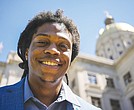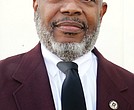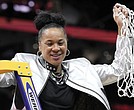Personality: Ginna Cullen
Spotlight on VAEA 2016-17 Art Educator of the Year
2/3/2017, 8:08 p.m.
When Ginna Cullen was an art teacher in Louisa County Public Schools, she noticed one student’s ability to beautifully cornrow hair and challenged her student’s skill for a final exam.
“I told her to cornrow a white classmate’s hair,” she said. “You should have heard the way she fussed about having to cornrow that white girl’s hair,” she said with a laugh.
Ms. Cullen’s unconventional teaching methods, combined with her passion for art and public education, earned her the 2016-17 Art Educator of the Year Award from the Virginia Art Education Association.
She was nominated by the group’s president, Linda Conti, and presented with the award last fall during the Virginia Art Education Association’s annual conference in Norfolk.
This year marks Ms. Cullen’s 50th year of teaching. She has gone from teaching younger students in public schools to teaching on the college level. She now works at Virginia Commonwealth University as an adjunct art instructor and as regional program coordinator of off-campus graduate art programs.
That’s an impressive feat for someone who originally had her eye on a math career. Her father, an industrial chemist, introduced her to math at an early age.
“He made it interesting, so math was never difficult to me. It made sense,” she says.
She loved art as well. But when she enrolled at the University of Mary Washington, she decided to focus on math. As she advanced, Ms. Cullen realized that her ease and love of math ended with calculus.
“Everything went dark,” she says. “And I thought to myself, ‘I’ve got to get back to art.’ ”
So during her junior year, she changed her major to art.
Although she recognizes art and math as two different fields, she believes them to be founded on the same principle: Problem solving. In this sense, she says, the relevance of art in public school education carries just as much weight as math does.
“I think there is an artist in all of us because creating is essential to us as a species,” she says. ”We spend a lot of time denying it, but it’s really who we are.”
Ms. Cullen began her teaching career in Manassas in 1967, when public schools in the Northern Virginia city were beginning to integrate.
“The experience opened my eyes to a lot that I did not know,” she says. “My students taught me a lot more than I taught them.”
She says she made a point of introducing her students to African-American artists. Today, she is part of a master’s degree outreach program at VCU in art education that travels to public schools across the state to instruct student teachers.
In addition to her contributions in public schools, Ms. Cullen has served on several boards, including the Louisa County Education Association, where she was treasurer, and as the director of the gallery at the Louisa Arts Center. Her work has been shown as part of solo art exhibitions, traveling exhibitions, gallery shows and invitational exhibitions.
Meet this week’s Personality and arts advocate, Ginna Cullen:
Latest honor: Recipient of the 2016-17 Art Educator of the Year Award from the Virginia Art Education Association.
Date and place of birth: Aug. 20 in Fredericksburg.
Current residence: Louisa County.
Alma maters: Bachelor of fine arts, University of Mary Washington; master’s degree in interdisciplinary studies, Virginia Commonwealth University.
Family: Husband, John Cullen, and two sons, David and Jack Cullen.
What this award means to me: This year marks 50 years since I started teaching. It is an incredible honor to be recognized by your peers. Art for me is: Who I am, what I love and necessary for all of us.
Why teaching turns me on: There is nothing greater than teaching something to a student and having them believe, within themselves, that they can actually do it.
When I was introduced to art: In elementary school, third grade.
My greatest artistic influence: My best friend’s mom. I used to hang out and watch her paint. She was one of the best instructors I had while studying art.
Teaching for me is: When you are teaching youngsters art, you aren’t teaching them to be a painter or an artist. You are teaching them problem solving. If math were taught like art, so many more students would understand math.
Why I became a teacher: It kind of runs in the family. My mom was a teacher. So were my aunts and cousins. I was around people who were teaching all of the time, so you pick up those skills.
My teaching philosophy: If you are going to be a teacher, you need to know whatever it is you are teaching and love it with a passion, so you can pass that on to the students.
My favorite artists: Milton Avery, because I love his sense of color. John Biggers is my other favorite, because I like the repetition in his work. It’s kind of like quiltmaking.
What is the relevance of art to the growth and development of our young people: Art teaches them to problem solve, which can carry over into their careers. Young people need to learn to make things. They need to understand the visual world around them. Drawing is a skill, and once you get past people’s perception of “I can’t draw,” it opens doors for them, leading to other learning possibilities.
If I could have my wish, it would be: To fully fund art education for every school in the nation and make it accessible to everyone.
When I get restless and need to unwind I: Make something, read a book or paint. I have to stay busy.
What people think when they first meet me: I hope they find me likeable and interesting.
The one thing I can’t stand: A lack of integrity.
Best late-night snack: Chocolate.
The person who influenced me the most: My husband. He’s my biggest fan.
The book that influenced me the most: I remember reading “My Name is Asher Lev” by Chaim Potok. I like it so much, I often assign it to my students.
What I’m reading now: “All the Light We Cannot See” by Anthony Doerr.
My next goal: To continue teaching.







